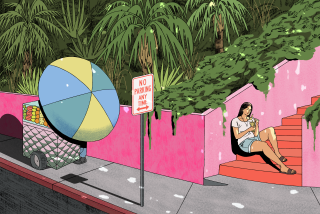After 20 years, L.A. Youth newspaper is keeping it real
- Share via
For a grown-up, the teen newspaper L.A. Youth is a peek into a parallel universe -- a display of unflinching adolescent honesty and our region’s dizzying diversity.
The newspaper -- 20 years old last month -- has become a confessional of sorts for teens, and a sobering reminder to adults of the challenges kids face in this high-tech, quick-fix, sex-obsessed city.
When L.A. Youth founder Donna Myrow leafed through the newspaper’s back issues last fall, to prepare for this year’s anniversary, she discovered that “every one had at least one story on what we’d call ‘mental health’ issues -- eating disorders, attempted suicides, domestic violence, parents’ gambling. . . .
“And over the years, the stories have become much more dramatic.”
The paper -- written by and for teens -- wasn’t intended to be an emotional repository when it was launched by Myrow, a teacher and mother of three, after the U.S. Supreme Court gave principals the right to censor school newspapers.
“Kids were being shut out of the conversation,” she told me, “just when we needed to hear from them.”
She began with a small group of student journalists, publishing two issues a year and taking the 2,500 copies to teachers in the trunk of her car. Now, more than 100,000 copies are distributed five times a year to hundreds of schools, libraries and community centers.
The paper earned its journalistic chops with early investigative stories on kids wrongly confined in mental hospitals and on West Los Angeles teens manhandled by police.
But the paper’s style and subject matter evolved as Myrow solicited contributions from students across L.A. County.
The writers come up with their own ideas at Saturday brainstorming meetings, so the paper reflects their personal interests, complaints and perspectives.
Many have such tumultuous lives that their newspaper stories tear at my heart.
Myrow recruits teens from group homes, shelters and juvenile halls, and they share unstinting accounts of abusive parents, uncaring authorities and brutal streets.
Stories such as one by Trayvione, who wrote in September 2006 of being removed from his home with a drug-addicted mother when he was 7, being molested by his older cousins and fighting his way through a dozen foster care families and group homes before landing in one devoted to gay teens.
I met the 18-year-old at the paper’s 20th anniversary celebration this week.
He was charming and articulate, nothing like the angry, wild-eyed kid I’d expected from reading about his past.
Sharing his story in print was like therapy. “I needed to get it off my chest,” he said. “I’d never told anyone before.”
Not all of L.A. Youth’s content is so weighty. Recent issues included a story by a Walnut High “environmental geek” about the fun he had building a solar car; a Marshall High honor student’s confession that she’s afraid to go off to college; and an account by two girls from Notre Dame Academy of a day spent riding city buses.
Other articles mine typical teen insecurities: A boy with his first girlfriend worries that his friends won’t like her. An overweight kid shares his hurt at being called “pig” by his classmates and kicked off the soccer team.
In almost every case, the writers’ names and photos run with their stories.
This is a generation, after all, comfortable with notoriety.
Almost six in 10 teenagers today blog; post stories, photos and videos online; or have their own personal Web pages, according to a Pew survey.
But these junior journalists have found there’s something different -- less instant, but more satisfying -- about the process of bringing a story to life, the prospect of seeing your byline in print, having your article passed around in class, bringing it home to show family and friends.
“I knew it would be read by my classmates and my friends, and didn’t know how people would react,” said Trayvione, who braced himself for slurs and ridicule. Instead, “I heard people say it inspired them. They started reading the newspaper, looking for me in it.”
That’s music to a newspaper columnist’s ears.
More to Read
Sign up for Essential California
The most important California stories and recommendations in your inbox every morning.
You may occasionally receive promotional content from the Los Angeles Times.













